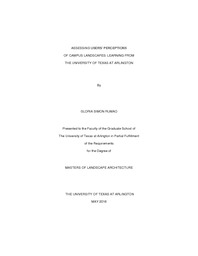
ATTENTION: The works hosted here are being migrated to a new repository that will consolidate resources, improve discoverability, and better show UTA's research impact on the global community. We will update authors as the migration progresses. Please see MavMatrix for more information.
Show simple item record
| dc.contributor.advisor | Ozdil, Taner R. | |
| dc.creator | Rumao, Gloria Simon | |
| dc.date.accessioned | 2016-07-08T19:59:15Z | |
| dc.date.available | 2016-07-08T19:59:15Z | |
| dc.date.created | 2016-05 | |
| dc.date.issued | 2016-05-10 | |
| dc.date.submitted | May 2016 | |
| dc.identifier.uri | http://hdl.handle.net/10106/25765 | |
| dc.description.abstract | The purpose of this study is to assess users’ perceptions of The University of Texas at Arlington’s campus landscape. This research focuses on The University of Texas at Arlington’s campus landscape design element and characteristics. It also discusses the users’ experiences in the campus landscapes and draws lessons to enlighten future landscape architecture practice. The University of Texas at Arlington (UT Arlington) is located in the Dallas-Fort Worth metropolitan area and is the second largest public university in the UT system. Approximately 40,000 people use the UT Arlington campus every day.
The review of literature demonstrates that campus landscapes are critical to understand and study because the relationship of people and campus environments becomes intimate when individuals feel a sense of belonging to the place they visit every day. In the historical backdrop of American campuses, most of the time the campus master plan will be more of an arrangement of building with spaces created amongst them (Marcus & Francis, 1998). In history, design of a campus was predominantly about structures and had less focus on landscapes. Nevertheless, campus designers’ perspective on campus design has changed over time. Students often choose an institution based upon their impression and perception of a campus (Griffith, 1994).
Campus landscape design plays an integral role in enrollment and retention of students and securing staff and faculty. Campus landscaping is becoming the new public face of universities (Ozdil et.al, 2013). As a result, the manner in which campus landscapes designed may entail more serious scrutiny than before.
This research uses quantitative techniques (Deming & Swaffield, 2011) to assess users’ perceptions of the UT Arlington campus landscape. Data collection methods include online surveys of campus users, passive observations, and the review of archival and secondary data. The survey population included students, faculty, and staff of UT Arlington and was voluntary participation. Researcher conducted passive observations to document and illustrate the use of campus landscapes (Francis & Marcus, 1998). While survey data is analyzed reviewing descriptive statistics and frequencies, the data triangulation method is used to combine findings from surveys, passive observations and archival and secondary data (Cohen and Manion 1986).
The findings from this research point out users’ opinions of various aspects of campus landscapes at UT Arlington. Results of the study reveal that design characteristics such as gathering areas, sitting areas, trees and vegetation affect users’ experience on campus the most. This research focuses on the UT Arlington campus landscape and can serve to enlighten future landscape architecture practice. In future planning and designing of campuses, these recommendations can help to enhance the quality and usability of campus landscapes. | |
| dc.format.mimetype | application/pdf | |
| dc.language.iso | en_US | |
| dc.subject | Campus landscape | |
| dc.title | ASSESSING USERS’ PERCEPTIONS OF CAMPUS LANDSCAPES: LEARNING FROM THE UNIVERSITY OF TEXAS AT ARLINGTON | |
| dc.type | Thesis | |
| dc.degree.department | Landscape Architecture | |
| dc.degree.name | Master of Landscape Architecture | |
| dc.date.updated | 2016-07-08T20:01:23Z | |
| thesis.degree.department | Landscape Architecture | |
| thesis.degree.grantor | The University of Texas at Arlington | |
| thesis.degree.level | Masters | |
| thesis.degree.name | Master of Landscape Architecture | |
| dc.type.material | text | |
Files in this item
- Name:
- RUMAO-THESIS-2016.pdf
- Size:
- 6.049Mb
- Format:
- PDF
This item appears in the following Collection(s)
Show simple item record


